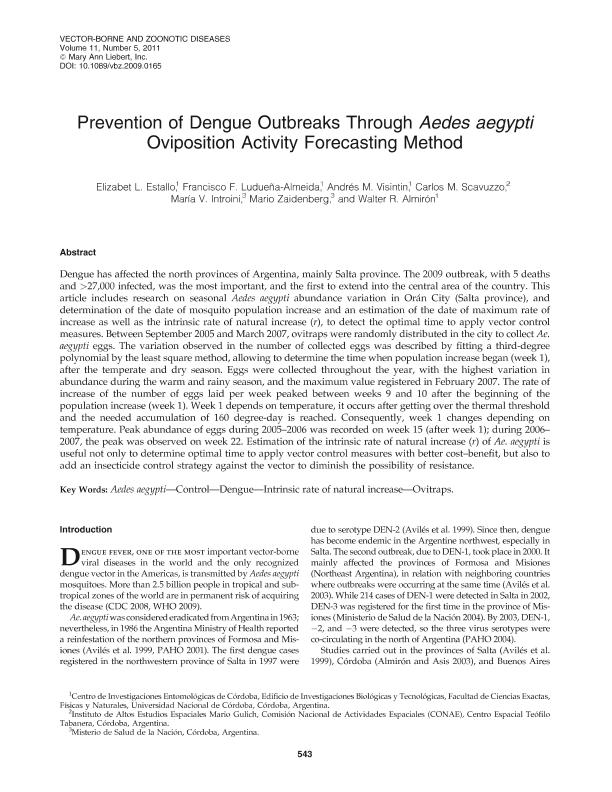Mostrar el registro sencillo del ítem
dc.contributor.author
Estallo, Elizabet Lilia

dc.contributor.author
Ludueña Almeida, Francisco

dc.contributor.author
Visintin, Andrés Mario

dc.contributor.author
Scavuzzo, Carlos Marcelo

dc.contributor.author
Introini, María Virginia
dc.contributor.author
Zaidenberg, Mario
dc.contributor.author
Almiron, Walter Ricardo

dc.date.available
2019-05-20T15:41:32Z
dc.date.issued
2011-05
dc.identifier.citation
Estallo, Elizabet Lilia; Ludueña Almeida, Francisco; Visintin, Andrés Mario; Scavuzzo, Carlos Marcelo; Introini, María Virginia; et al.; Prevention of dengue outbreaks through aedes aegypti oviposition activity forecasting method; Mary Ann Liebert; Vector-borne And Zoonotic Diseases; 11; 5; 5-2011; 543-549
dc.identifier.issn
1530-3667
dc.identifier.uri
http://hdl.handle.net/11336/76710
dc.description.abstract
Dengue has affected the north provinces of Argentina, mainly Salta province. The 2009 outbreak, with 5 deaths and >27,000 infected, was the most important, and the first to extend into the central area of the country. This article includes research on seasonal Aedes aegypti abundance variation in Orán City (Salta province), and determination of the date of mosquito population increase and an estimation of the date of maximum rate of increase as well as the intrinsic rate of natural increase (r), to detect the optimal time to apply vector control measures. Between September 2005 and March 2007, ovitraps were randomly distributed in the city to collect Ae. aegypti eggs. The variation observed in the number of collected eggs was described by fitting a third-degree polynomial by the least square method, allowing to determine the time when population increase began (week 1), after the temperate and dry season. Eggs were collected throughout the year, with the highest variation in abundance during the warm and rainy season, and the maximum value registered in February 2007. The rate of increase of the number of eggs laid per week peaked between weeks 9 and 10 after the beginning of the population increase (week 1). Week 1 depends on temperature, it occurs after getting over the thermal threshold and the needed accumulation of 160 degree-day is reached. Consequently, week 1 changes depending on temperature. Peak abundance of eggs during 2005-2006 was recorded on week 15 (after week 1); during 2006-2007, the peak was observed on week 22. Estimation of the intrinsic rate of natural increase (r) of Ae. aegypti is useful not only to determine optimal time to apply vector control measures with better cost-benefit, but also to add an insecticide control strategy against the vector to diminish the possibility of resistance.
dc.format
application/pdf
dc.language.iso
eng
dc.publisher
Mary Ann Liebert

dc.rights
info:eu-repo/semantics/openAccess
dc.rights.uri
https://creativecommons.org/licenses/by-nc-sa/2.5/ar/
dc.subject
Aedes Aegypti
dc.subject
Control
dc.subject
Dengue
dc.subject
Intrinsic Rate of Natural Increase
dc.subject
Ovitraps
dc.subject.classification
Otras Ciencias Biológicas

dc.subject.classification
Ciencias Biológicas

dc.subject.classification
CIENCIAS NATURALES Y EXACTAS

dc.title
Prevention of dengue outbreaks through aedes aegypti oviposition activity forecasting method
dc.type
info:eu-repo/semantics/article
dc.type
info:ar-repo/semantics/artículo
dc.type
info:eu-repo/semantics/publishedVersion
dc.date.updated
2019-05-14T17:38:07Z
dc.identifier.eissn
1557-7759
dc.journal.volume
11
dc.journal.number
5
dc.journal.pagination
543-549
dc.journal.pais
Estados Unidos

dc.description.fil
Fil: Estallo, Elizabet Lilia. Consejo Nacional de Investigaciones Científicas y Técnicas. Centro Científico Tecnológico Conicet - Córdoba. Instituto de Investigaciones Biológicas y Tecnológicas. Universidad Nacional de Córdoba. Facultad de Ciencias Exactas, Físicas y Naturales. Instituto de Investigaciones Biológicas y Tecnológicas; Argentina
dc.description.fil
Fil: Ludueña Almeida, Francisco. Consejo Nacional de Investigaciones Científicas y Técnicas. Centro Científico Tecnológico Conicet - Córdoba. Instituto de Investigaciones Biológicas y Tecnológicas. Universidad Nacional de Córdoba. Facultad de Ciencias Exactas, Físicas y Naturales. Instituto de Investigaciones Biológicas y Tecnológicas; Argentina
dc.description.fil
Fil: Visintin, Andrés Mario. Consejo Nacional de Investigaciones Científicas y Técnicas. Centro Científico Tecnológico Conicet - Córdoba. Instituto de Investigaciones Biológicas y Tecnológicas. Universidad Nacional de Córdoba. Facultad de Ciencias Exactas, Físicas y Naturales. Instituto de Investigaciones Biológicas y Tecnológicas; Argentina
dc.description.fil
Fil: Scavuzzo, Carlos Marcelo. Comision Nacional de Actividades Espaciales. Instituto de Altos Estudios Espaciales "Mario Gulich"; Argentina
dc.description.fil
Fil: Introini, María Virginia. Ministerio de Salud. Dirección de Enfermedades Transmisibles Por Vectores; Argentina
dc.description.fil
Fil: Zaidenberg, Mario. Ministerio de Salud. Dirección de Enfermedades Transmisibles Por Vectores; Argentina
dc.description.fil
Fil: Almiron, Walter Ricardo. Consejo Nacional de Investigaciones Científicas y Técnicas. Centro Científico Tecnológico Conicet - Córdoba. Instituto de Investigaciones Biológicas y Tecnológicas. Universidad Nacional de Córdoba. Facultad de Ciencias Exactas, Físicas y Naturales. Instituto de Investigaciones Biológicas y Tecnológicas; Argentina
dc.journal.title
Vector-borne And Zoonotic Diseases

dc.relation.alternativeid
info:eu-repo/semantics/altIdentifier/url/https://www.ncbi.nlm.nih.gov/pubmed/20925528
dc.relation.alternativeid
info:eu-repo/semantics/altIdentifier/doi/http://dx.doi.org/10.1089/vbz.2009.0165
Archivos asociados
